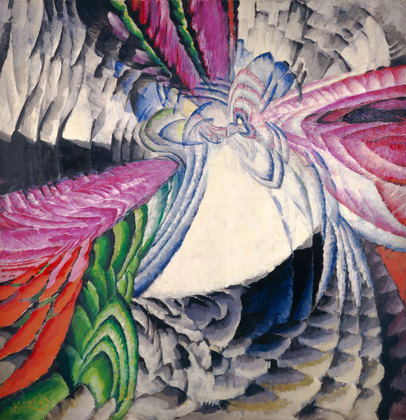Art Trip New York : The true origins of abstraction

František Kupka. Localization of Graphic Motifs II. 1912–13. Oil on canvas, 78 3/4 x 76 3/8″ National Gallery of Art, Washington, D.C.
MoMa’s exhibit in New York, Inventing Abstraction 1910-1925; how a Radical Idea Changed Modern Art, is extraordinary. As per the Museum’s website, the show traces the “development of abstraction as it moved through a network of modern artists”. The title of the event seems a bit flashy, but one has to admit that it is great marketing tool to bring crowds to the venerated art institution. It may be misleading too, because I do not think that abstraction was invented at a precise moment in history, 1910, but rather, it was the result of a long process that started since the time of the Sistine Chapel when Michelangelo gave us the opportunity to see in another way. We shall also underline his fellow painters of the time, the Mannerists. Let us explain.
In the Western world, from the Bronze Age to the Florentine Renaissance, there was a long artistic journey to reach perfect mimesis (to imitate reality) and civilization nearly reached that perfection when the Romans Cicero and Seneca were writing. But Christianity officially arrived on Imperial Rome (313) with its great “recoil” of art (Panofsky) which happened for various reasons (too lengthy to explain here), the main one being the broader concept of Christian global vision of the world. When 12 centuries later, the “great three” (Michelangelo, Raphael and Da Vinci) reached intentionally the podium of mimesis, the world of painting arrived to the conclusion: “OK, what do we do now? Are we going to paint like this for what is left of History?”
To that question, a resounding “no” was answered by the Mannerist painters (17th century), who had started to break all the conventional rules established by various art treaties abundantly published at the time. Bronzino, Beccafumi, Allori, Parmigianino were pushing the notorious Quattrocento vanishing point outside the painting. Then Caravaggio arrived (Doubting Thomas) making sure that this vanishing point resided outside the frame; moreover, with an intense use of chiaroscuro, he made his paintings mere juxtaposition of dark and light shapes, hence making a Baroque composition a much flatter painting; Rembrandt and Rubens will follow. And later, what about Turner’s visions whom Monet saw when he resided momentarily in London in 1870. All these painters are in facts the originators of abstraction, but they didn’t know it yet. Abstraction was not yet a concept fully apprehended intentionally.
All these pictorial ruptures with the past also found reason in the fantastic evolution of science which occurred in the 17th and 18th century with Pascal, Torricelli, Newton, just to name a few. Scientific discoveries banished for good the merry old ways of thinking (scholastic) to fully embrace rationalism and empiricism. And, many decades later, knowledge will make room to “subjective truth” or “objective uncertainty” (Kierkegaard); what cannot be proven scientifically becomes a commitment, a leap of faith, something to believe in, to take part in, to live in a certain kind of way, one of them, the artist way. Everything changed!
In the beginning of the 19th century, we became aware of new possibilities; we had choices: political choices, religious choices and societal choices. Awareness also brought the notion of intention in the arts, artistic choices. It was also the time of photography, which contributed to the rise of abstraction. Édouard Manet will manipulate space if he chooses to do so (Bar aux Folies Bergères); not the photographers (yet). “Freedom of choice”, the spirit of the time, also found its tenets in political revolutions and, of course, in Nietzsche’ freedom of choice.
I believe that it was only during the late 19th Century, that artists were intentionally journeying toward abstraction for all the reasons mentioned above, and it is with Cézanne’s later works (Corner of Quarry) that a full consciousness toward abstraction really set in. Then when Cezanne died in 1906, Picasso took over in 1907 with its Les demoiselles d’Avignon and analytical cubism.
To conclude, after reaching perfect mimesis is painting around 1520, there were three phases in the quest to abstraction: 1) unintentionally with the Mannerism, Baroque and Romanticism 2) not yet fully intentionally from Manet to Cézanne and 3) fully intentionally from 1910 to 1925, the theme of this great exhibition, Inventing Abstraction 1910-1925. The “great four” (Picasso, Kandinsky, Mondrian and Malevich) were fully aware of their actions, the reason most of them wrote extensively on their art, hence the “cerebral phase” of abstraction. But we had to wait for the publication of the Surrealist First Manifesto in 1924 to live the “visceral phase” of abstraction, a subject for another post.


Thanks, Yves. Very interesting! Marion
Marion Hall topdrawers@rogers.com